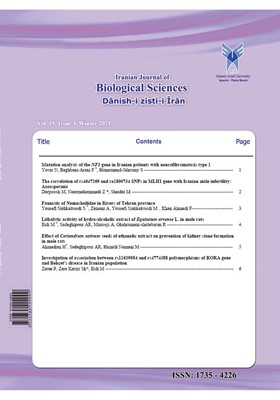Faunistic of Nemacheilidae in Rivers of Tehran province
Subject Areas : ZoologySiamak Yousefi Siahkalroodi 1 * , Ali Zamani 2 , Mahyar Yousefi Siahkalroodi 3 , Fatemeh Khan Ahmadi 4
1 - Department of Biology, Faculty of Biological Sciences, Varamin-Pishva Branch, Islamic Azad University, Pishva, Iran
2 - Department of Biology, Faculty of Biological Sciences, Varamin-Pishva Branch, Islamic Azad University, Pishva, Iran
3 - Faculty of Veterinary Medicine, Science and Research Branch, Islamic Azad University, Tehran, Iran
4 - Faculty of Veterinary Medicine, Science and Research Branch, Islamic Azad University, Tehran, Iran
Keywords: Iran, Species Diversity, Tehran province, Nemacheilidae,
Abstract :
Identification, species diversity and abundance of Nemacheilidae were carried out in the rivers of Tehran province from autumn 2018 to autumn 2019 for twelve months. For this purpose, 10 sampling stations were selected. The samples were catching by electroshock, then fixed with alcohol and transferred to laboratory for biometry. The results of this study showed that three species belonging to the Nemacheilidae live in Jajrood, Hablehrood and Lar Rivers in Tehran province. Oxynoemacheilus bergiana with 77.27% highest and Paracobitis iranian with 15% and Oxynoemacheilus angorae with 7.73% lowest species diversity at selected stations. Also in Saeedabad station, the frequency of Oxynoemacheilus bergiana was 77.27% and Paracobitis Iranian was 3.18%. At Khojir station, the frequency of Paracobitis iranian was 3.63%. In Zarrin Dasht and Simin Dasht stations, the frequency of Paracobitis iranian is equal to 4.1%. At Lar dam and Delicha stations, the abundance of Oxynoemacheilus angorae was 5.45% and 2.27%, respectively. Also, the highest density of fish caught in the season belonged to summer, autumn, spring and winter, respectively. The frequency of Oxynoemacheilus bergiana was 34.1% in summer, 20% in autumn, 11.8% in winter and 11.336 in spring. Paracobitis iranian was 8.63% in summer and 6.37% in spring. Oxynoemacheilus angorae was 5.45% in summer and 2.28% in autumn.
_||_

